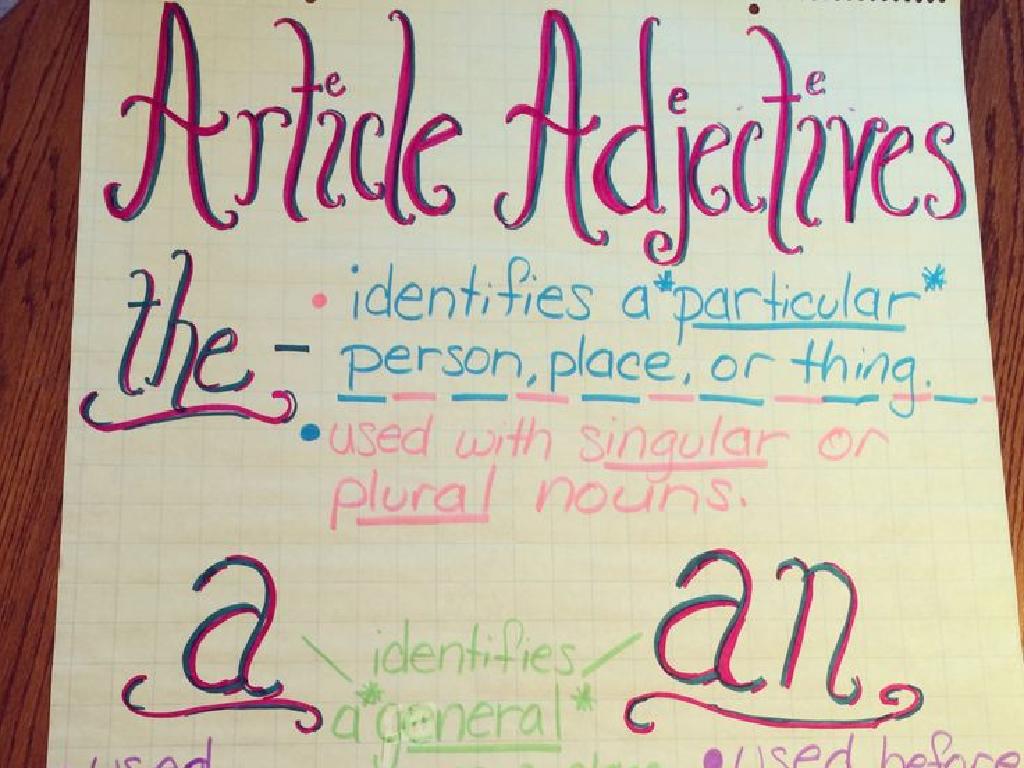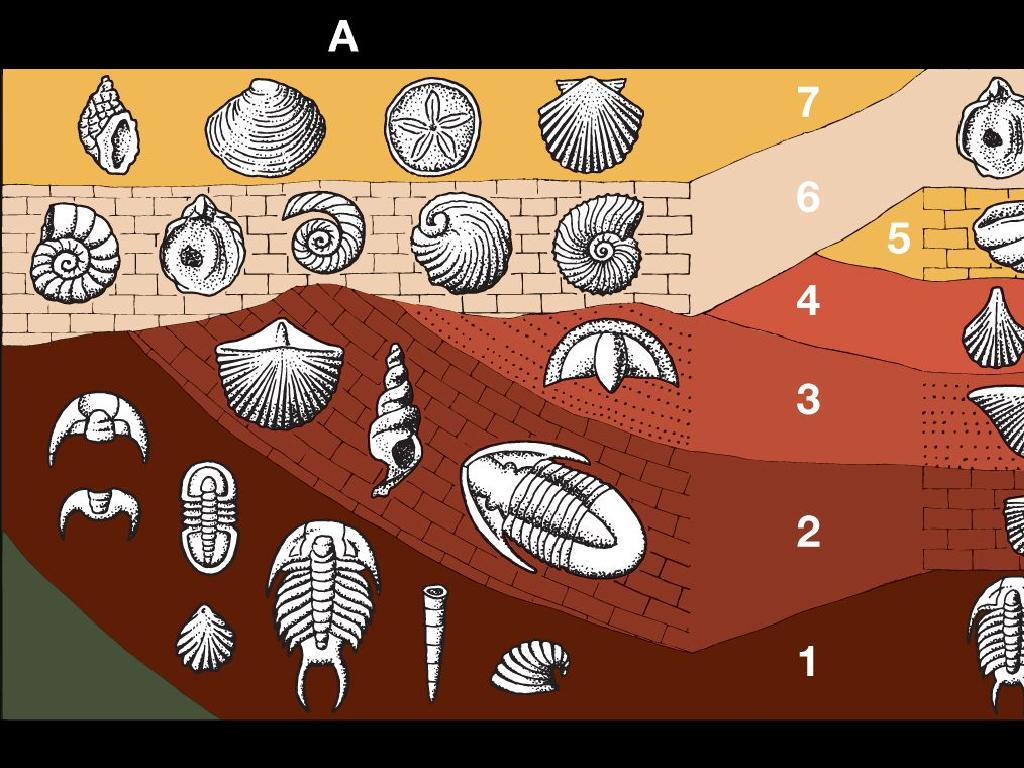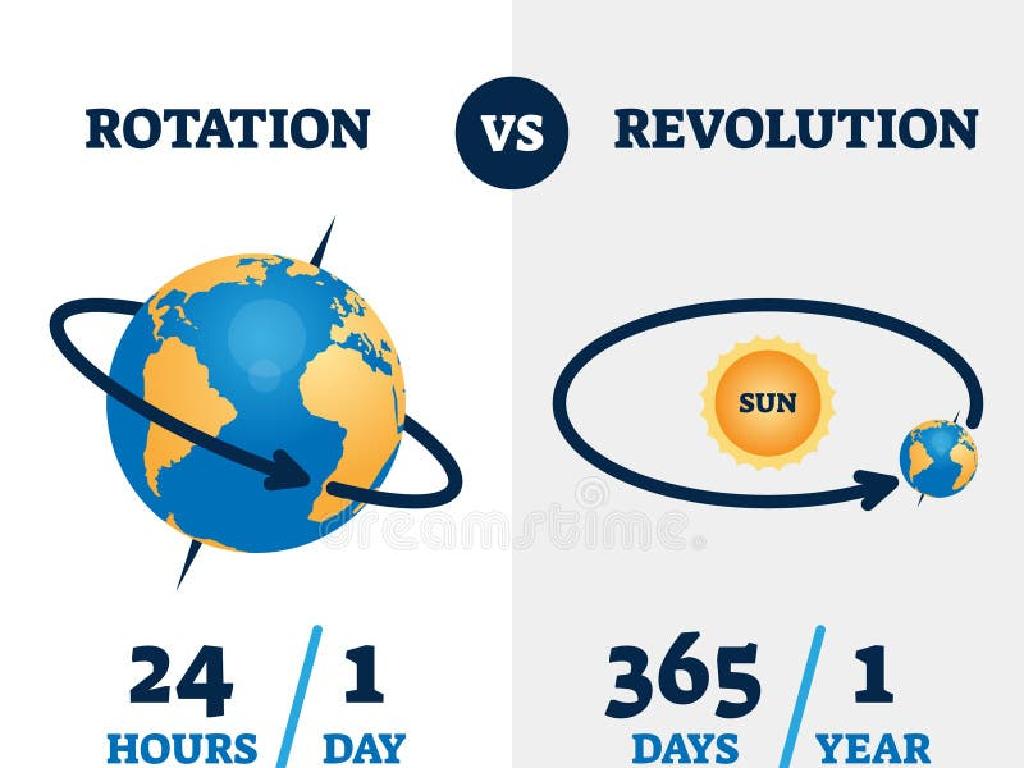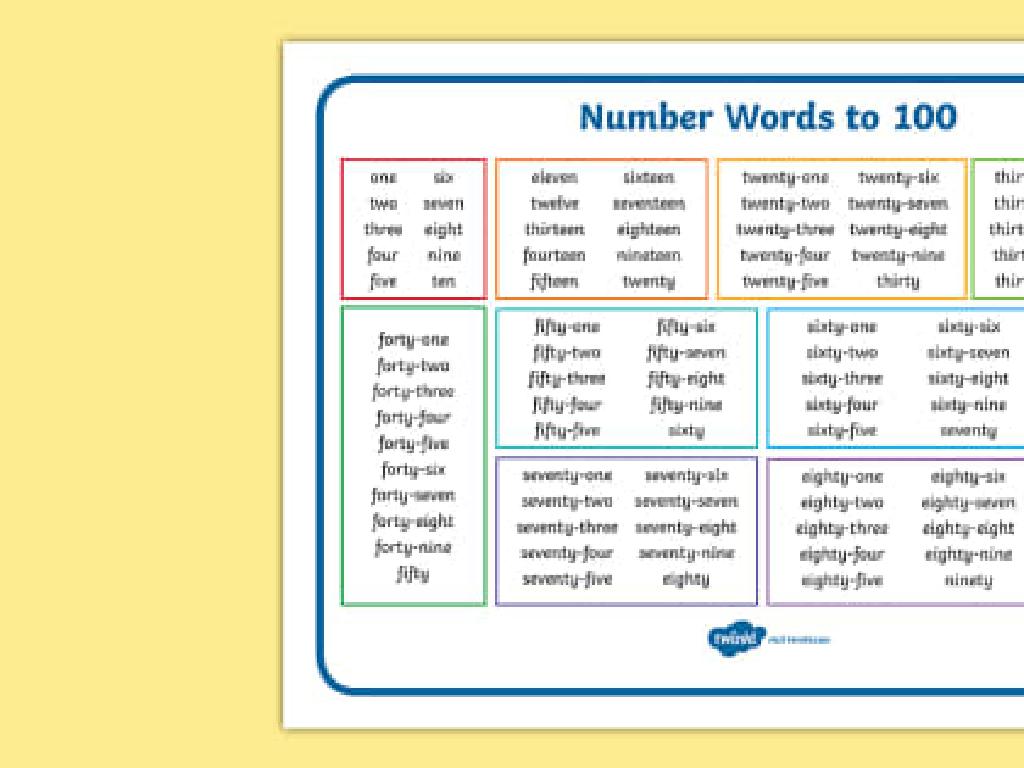Complete A Sequence - Up To 10
Subject: Math
Grade: Kindergarten
Topic: Counting Forward And Back To 10
Please LOG IN to download the presentation. Access is available to registered users only.
View More Content
Welcome to Counting: Sequences Up to 10
– Greetings, young mathematicians!
– Today’s focus: Learning sequences
– Sequences are patterns with rules
– Like 1, 2, 3 or 2, 4, 6, each step follows a rule
– We’ll practice counting up to 10
– Let’s fill in missing numbers together!
|
This slide introduces kindergarteners to the concept of sequences in a fun and engaging way. Start by greeting the students warmly to capture their attention. Explain that a sequence is a pattern that follows a specific rule, which makes numbers predictable. Use simple examples like counting by ones or twos to illustrate the concept of a sequence. During the lesson, encourage the children to participate by asking them to predict the next number in a sequence. Provide hands-on activities where they can practice completing sequences by filling in missing numbers up to 10. This will help them understand the order of numbers and improve their counting skills.
Understanding Sequences Up to 10
– What is a sequence?
– A sequence is a list of numbers in a specific order.
– Counting forward creates a sequence
– Start at 1 and count up to 10: 1, 2, 3, …
– Counting backward makes a sequence
– Start at 10 and count down to 1: 10, 9, 8, …
– Practice with sequences up to 10
– Let’s complete sequences together: 2, 3, __, 5
|
This slide introduces the concept of sequences to Kindergarten students, emphasizing the idea of order in numbers. Begin by explaining that a sequence is like a line of numbers where each has its own place. Demonstrate counting forward from 1 to 10 to show how each number comes next. Then, show counting backward from 10 to 1 as another way to create a sequence. Engage the students with hands-on practice by having them fill in missing numbers in sequences up to 10, reinforcing their understanding of number order. Encourage participation and use physical number cards or interactive games to make the activity more engaging.
Counting Forward Up to 10
– Counting from 1 to 10
– Let’s say the numbers together: 1, 2, 3, …
– Each number after 1
– What number comes after 1? Yes, it’s 2! Then comes 3!
– Practice counting aloud
– Repeat after me: 1, 2, 3, … up to 10
– Counting is fun and easy
|
This slide is designed to help Kindergarten students learn to count from 1 to 10. Start by counting together as a class to ensure they can follow along. Emphasize the sequence of numbers and encourage them to understand that each number is one more than the previous one. Engage the students by asking them to count with you and correct any mistakes gently. Make the activity interactive and enjoyable by using a cheerful voice and praising their efforts. By the end of the lesson, students should feel confident in counting from 1 to 10 on their own.
Counting Backward from 10
– Start at 10 and count down
– After 10 comes 9, then 8
– It’s like a countdown: 10, 9, 8…
– Counting down to 1
– Let’s count backward together
– Practice makes perfect! We’ll do it as a class.
|
This slide is aimed at teaching Kindergarten students the concept of counting backward from 10 to 1. Begin by explaining that counting backward is just like counting forward, but in reverse. Use simple language and encourage the children to visualize the numbers as they go down from 10. You can use your fingers to help them visualize each number as it decreases. Engage the class by counting together out loud, and consider incorporating a song or a rhythm to make it fun and memorable. As an activity, you can have the children practice by counting backward during clean-up time or when lining up, reinforcing the concept through repetition in daily routines.
Completing Number Sequences Up to 10
– Sequences might have gaps
– Use knowledge to find missing numbers
– If we have 1, 2, __, 4, what comes in the blank?
– Practice with example sequences
– Example: 5, 6, __, 8, __, 10
– Fill in the blanks together
– We’ll work as a class to solve these puzzles!
|
This slide introduces the concept of completing number sequences to Kindergarten students. Start by explaining that a sequence is a set of things (usually numbers) that are in a specific order. Sometimes, there are missing numbers in a sequence, and we can figure out what they are by looking at the numbers we already know. Use simple sequences that count up or down to 10 and have the children fill in the missing numbers. For example, if the sequence is 1, 2, __, 4, we know that the missing number is 3 because it comes after 2. Provide several examples and encourage the children to explain their thinking. This activity will help them understand the order of numbers and improve their counting skills.
Completing Number Sequences Up to 10
– Understand sequences up to 10
– Identify the missing number
– What comes after 1, 2? Yes, it’s 3!
– Practice with an example
– Let’s fill in: 1, 2, __, 4, 5. What’s missing?
– Share your answers
|
This slide is aimed at helping Kindergarten students understand and complete number sequences up to 10. Start by explaining what a sequence is, using physical objects like blocks or pictures to visually demonstrate the concept. Then, move on to identifying missing numbers in a sequence. Use the example provided to engage the students in a group activity where they can call out the missing number. Encourage them to explain how they found the answer. Finally, have students practice with similar sequences and share their answers with the class. This will help reinforce their counting skills and understanding of order in sequences.
Let’s Practice Sequences: Fill in the Blanks
– Now it’s your turn to try
– Look at the sequences provided
– Sequences with numbers up to 10
– Fill in the missing numbers
– Think: What comes next after 2, 4, ?, 8
– Use counting forward or backward
– If we have 10, 9, ?, what number is missing?
|
This slide is an interactive activity for students to practice completing number sequences up to 10. Encourage the children to look at the patterns and use their counting skills to identify the missing numbers. Provide sequences with one or two numbers missing and ask the students to fill in the blanks by counting forwards or backwards. For example, in the sequence 1, 2, ?, 4, the missing number is 3. In the sequence 10, ?, 8, the missing number is 9. Offer guidance and support as needed and praise their efforts to build confidence. This activity will help reinforce their understanding of number order and the concept of sequences.
Class Activity: Sequence Hopscotch
– Let’s play Sequence Hopscotch!
– Hop on numbers in order
– Start from 1 and hop to 10 in the right sequence
– If you miss a number, try again
– It’s okay to make mistakes, just start over
– Keep going until the sequence is complete
– Practice makes perfect! Can you hop without missing?
|
This interactive class activity is designed to help Kindergarten students understand numerical order through physical play. Set up a hopscotch grid with numbers up to 10. Students will hop on the numbers in the correct sequence, reinforcing their counting skills. If a student skips a number or hops on the wrong one, they’ll start over, providing immediate feedback and an opportunity to correct themselves. This activity caters to different learning styles, particularly kinesthetic learners. For variation, you can have students hop backward from 10 to 1, or create multiple hopscotch grids for simultaneous play. Encourage students to cheer each other on, fostering a supportive learning environment.
Sequence Masters: Great Job!
– Celebrating sequence completion
– You’re now sequence experts
– Sequences follow patterns
– Patterns help predict the next numbers
– Keep practicing order and patterns
– Practice with toys, snacks, or steps
|
This slide is a conclusion to reinforce the students’ understanding and confidence in completing sequences up to 10. It’s a celebration of their achievement in becoming ‘sequence experts.’ Emphasize that sequences are about recognizing patterns and maintaining order, which are fundamental skills in mathematics. Encourage them to keep practicing with everyday items to strengthen their grasp of sequences. For example, they can arrange their toys in a sequence or count their steps in a pattern. This will help them see the practical application of sequences in their daily lives and make learning fun.






